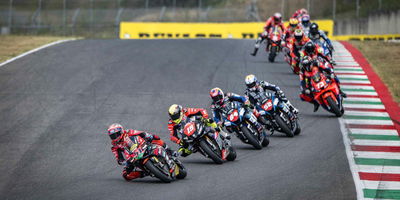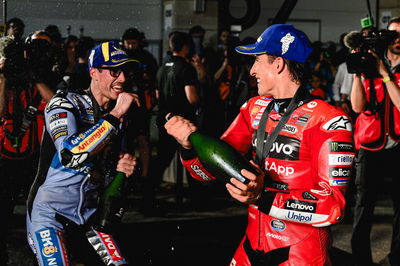Pecco Bagnaia’s risk-reward balance | Three talking points from the Aragon MotoGP
Here are five major talking points from the Aragon MotoGP at MotorLand.

There wasn’t a lot going on at the front of last weekend’s Aragon MotoGP, but from rediscovering one champion’s dominance to once again encountering the flaw of another there was much to take in.
What did Marquez’s victory actually teach us?
In many ways, Marc Marquez’s victory in the Aragon Grand Prix, and the Sprint on Saturday, left us with more questions than answers.
Marquez arrived in Aragon off the back of arguably his best race of the season in Austria. He finished fourth in the GP there and crashed out of the Sprint, but at a circuit which is not noted as one at which Marquez has some kind of advantage — like, say, Sachsenring — he showed pace that would have put him in contention with the likes of second-placed Jorge Martin had he not made mistakes.
In that way, Aragon’s result was inevitable. Marquez had clearly found a step with the Desmosedici compared to previous races, and coming to MotorLand — a circuit noted as one where Marquez certainly does have some kind of advantage — it only made sense that he would win.
That he did, then, only proves that he will be fighting among the top positions for the rest of the season, especially considering his significant margin over the rest of the field.
But it’s not quite as simple as that, because neither Austria nor Aragon were straightforward weekends.
In Austria, the riders had to contend with the harder-construction rear tyre aimed at dissipating heat to deal with the circuit’s many hard acceleration zones, a tyre which is fundamentally different to that which is run at almost every other circuit.
Then, in Aragon, a fresh and dirty track surface played right into Marquez’s hands, because his affinity for dirt tracking makes him especially potent on low-grip surfaces. With overnight rain on both Friday and Saturday, the advantage Marquez had never really reduced over the weekend because the track conditions never got better than they were on Friday afternoon.
That doesn’t mean that Marquez was undeserving of his victory in Aragon, because his advantage came from himself, his riding style, and his own abilities in those conditions.
But even he admitted that the conditions in Aragon were “special” in the post-race press conference, just as the tyre was special in Austria.
In that respect, MotoGP hasn’t had a ‘normal’ weekend in terms of conditions since Silverstone, where Marquez was uncomfortable all weekend.
Austria’s tyre and Aragon’s track surface means that only in Misano are we likely to see exactly how Marquez stacks up against the likes of Francesco Bagnaia and Jorge Martin in ordinary conditions.
Bagnaia’s risk-reward balance
The balance of risk versus reward is one that all racers have to consider at almost all moments, and it seems that Francesco Bagnaia misjudged it in Aragon.
His crash with Alex Marquez on lap 18 of the Grand Prix was both unnecessary and avoidable. If only he’d been more patient, he’d have had the chance to pass Marquez with ease in the four-and-a-bit remaining laps.
But that’s not necessarily true.
In the top six positions, there was only one overtake in the whole race which didn’t come from one rider’s mistake: Jorge Martin’s on Pedro Acosta in the back straight, and that came after Martin had misjudged a pass on Acosta at turn eight earlier on.
Other than that, the position changes in the top six positions came when Acosta almost high-sided on the exit of the final corner allowing Alex Marquez through; when Miguel Oliveira at turn 16 crashed to promote Bagnaia to sixth; when Franco Morbidelli ran wide at turn five to allow Bagnaia and Brad Binder into fifth and sixth, respectively; and when Acosta ran wide at turn 16 allowing Bagnaia through into fourth.
Brad Binder, for example, didn’t make one pass the whole race after lap one, despite staring at the rear wheel of Bagnaia, and then Acosta, only a few metres ahead of him for almost all of the 23 laps.
Therefore, it’s possible to say that overtaking at Aragon was exceptionally difficult on Sunday, mostly because of the incredibly narrow racing line and the amount of dirt that lay outside of it.
Trying to pick apart the incident, between Bagnaia and Marquez, itself is essentially pointless if the aim is to decide definitively who was to blame, since both riders made mistakes.
Marquez should have checked left has he rejoined the line, as he did when he made a similar mistake at turn one on lap three with Franco Morbidelli behind him; and Bagnaia should have left more space, or backed out of the move entirely if he thought he couldn’t leave space because of the narrow racing line and the state of the track outside of that.
They were both to blame, but with Alex Marquez not in contention for the championship and with his future secure, there’s no doubt who was the biggest loser of the contact.
And that is, perhaps, the main point, that Bagnaia seems to end up losing out in these kinds of scenarios much more often than some of his rivals, notably Jorge Martin who has finished second in the last six races and now leads the championship by 23 points.
You think about the Aragon incident, the Portimao incident with Marc Marquez, the Le Mans 2023 incident with Maverick Vinales — even his 2022 Motegi crash while trying to pass Fabio Quartararo.
They’re all similar to each other in that they can, arguably, be put down, to some extent, to Bagnaia being reluctant to give up space, or to pass up an opportunity.
In that respect, the above incidents are also similar to, for example, Bagnaia’s around-the-outside pass on Jorge Martin at Jerez last year, his around-the-outside pass on Martin at Malaysia last year, his double pass down the outside of Martin and Marco Bezzecchi at Jerez this year, his turn nine-10 combat with Marc Marquez in the same race, his charge to first on lap one at Qatar this year, and his similar charge at Mugello this year.
In short, if it’s a mentality thing for Bagnaia, it’s one that takes away, but also that yields its rewards.
Bagnaia understands that positions given up now are much harder to win back later in most cases (examples of exceptions being Phillip Island last year, or Catalunya this year), mostly because of front tyre pressure.
In Aragon, he knew how hard and risky it was to force an overtake, so when he thought one had been handed to him, by Marquez's turn 12 mistake, he tried to take it. It didn’t pay off, but it’s that kind of thinking that also produces the best of Bagnaia: the Jerez, Mugello, Malaysia moments.
Backwards in going forwards
Pedro Acosta’s rookie MotoGP season started fantastically, but Aragon was his first Grand Prix podium since the Americas GP in April.
Why? KTM had been developing to try to make its RC16 faster, to improve its outright potential in terms of lap time. But, as it continued down this path, it cost Acosta his feeling and his comfort, and the ultimate result was the 13th place in Austria.
Acosta’s podium return in Aragon came at least in part because of a reversion in bike specification to one he’d run earlier in the year and with which he was more comfortable. The result of that was more lap time, and more consistency, and therefore a better race time and position.
It’s also worth pointing out, though, that in the fastest session of the weekend, Practice, none of the KTMs were in the top 10, and therefore they all missed Q2.
After overnight rain on Friday, the track was dirty again for qualifying on Saturday, and both Acosta and Brad Binder made it through to Q2, Acosta then qualifying on the front row.
More overnight rain from Saturday to Sunday meant the track was still dirty for the GP, and the KTMs were still fast, Acosta finishing third, ahead of Binder in fourth.
So, if the KTMs were fast in the dirt — which makes sense considering the often-sideways style in which the RC16 is ridden by the likes of Acosta, Binder and Jack Miller in particular — and slow when the track was cleaner, did they actually make a step forward by reverting their specification or not?
As with Marquez, it’s not really possible to tell for certain until motorcycles return to the track at Misano for this weekend's Grand Prix of San Marino.












